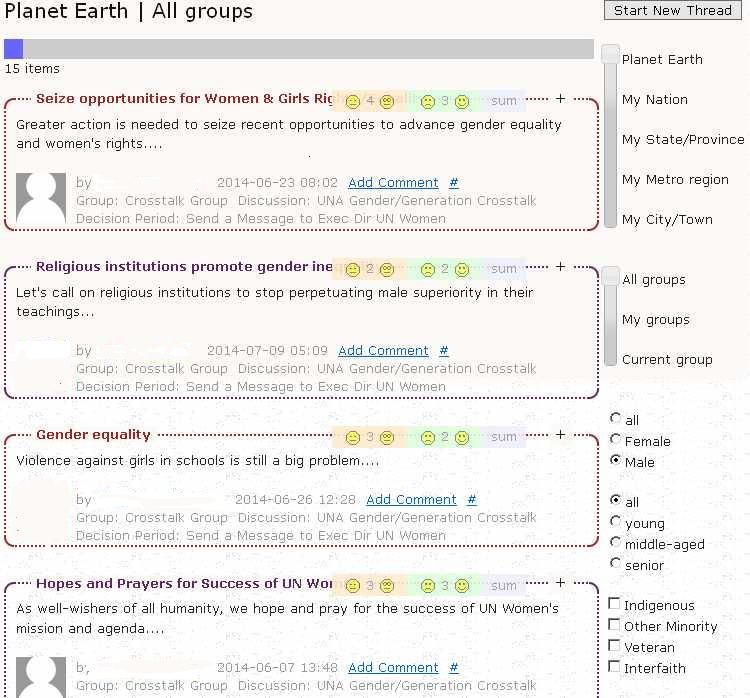The International Federation of Gynecology and Obstetrics (FIGO) has recently published an important “opinion on reproductive health impacts of exposure to toxic environmental chemicals”. See http://www.ijgo.org/article/S0020-7292%2815%2900590-1/fulltext. The article has been picked up and popularized by outlets as diverse as Mother Jones and Fox News.
A quick examination of the 17 UN Sustainable Development Goals (SDGs) and the associated 169 targets shows that at least 9 of the goals and 14 of the targets are related to the article. See below.
How will the SDGs act as an organizing framework? It is simple enough. A link to the FIGO article will be posted with a description in the Voices of Humanity online discussion and tagged for each of the SDG goals and targets listed below. For instance, the hierarchical hashtag #sdgs#3#2 would translate into three tags: #sdgs, #sdgs_3 and #sdgs_3_2. The article would thus be accessible to those who are interested in SDGs generally, or in Goal 3, or most particularly in Target 2 under Goal 3. For those who know, neonatal mortality is far from what it should be here in the Bay Area, so this is a good way to keep all the interested local parties in the know. At the same time, by changing the Voices of Humanity geographic level up to the state, national or global, the conversation can be expanded to bring in other points of view, and perhaps some novel best practices in the area of neonatal mortality.
If we lock on the FIGO post and expand from #sdgs_3_2 to #sdgs, we will see comments from people who are interested from other points of view. The philosophy behind the SDGs is that all the goals are interrelated, though of course some more closely than others. But how to have a conversation that both goes across the SDG boundaries and allows the proper focus on each? The Voices of Humanity technology is one answer. Please see the previous article for more context: voicesofhumanity.org/voices-of-humanity-un-goals-as-a-scaffold-for-local-to-global-organizing. And see at the bottom of the post for how the new geographic levels and related controls will look.
Here are the goals and targets that relate to the FIGO publication:
Goal 3. Ensure healthy lives and promote well-being for all at all ages
3.2 By 2030, end preventable deaths of newborns and children under 5 years of age, with all countries aiming to reduce neonatal mortality to at least as low as 12 per 1,000 live births and under-5 mortality to at least as low as 25 per 1,000 live births
3.4 By 2030, reduce by one third premature mortality from non-communicable diseases through prevention and treatment and promote mental health and well-being
3.7 By 2030, ensure universal access to sexual and reproductive health-care services, including for family planning, information and education, and the integration of reproductive health into national strategies and programmes
3.9 By 2030, substantially reduce the number of deaths and illnesses from hazardous chemicals and air, water and soil pollution and contamination
3.d Strengthen the capacity of all countries, in particular developing countries, for early warning, risk reduction and management of national and global health risks
Goal 5. Achieve gender equality and empower all women and girls
5.6 Ensure universal access to sexual and reproductive health and reproductive rights as agreed in accordance with the Programme of Action of the International Conference on Population and Development and the Beijing Platform for Action and the outcome documents of their review conferences
Goal 6. Ensure availability and sustainable management of water and sanitation for all
6.3 By 2030, improve water quality by reducing pollution, eliminating dumping and minimizing release of hazardous chemicals and materials, halving the proportion of untreated wastewater and substantially increasing recycling and safe reuse globally
Goal 7. Ensure access to affordable, reliable, sustainable and modern energy for all
7.a By 2030, enhance international cooperation to facilitate access to clean energy research and technology, including renewable energy, energy efficiency and advanced and cleaner fossil-fuel technology, and promote investment in energy infrastructure and clean energy technology
Goal 9. Build resilient infrastructure, promote inclusive and sustainable industrialization and foster innovation
9.4 By 2030, upgrade infrastructure and retrofit industries to make them sustainable, with increased resource-use efficiency and greater adoption of clean and environmentally sound technologies and industrial processes, with all countries taking action in accordance with their respective capabilities
Goal 11. Make cities and human settlements inclusive, safe, resilient and sustainable
11.6 By 2030, reduce the adverse per capita environmental impact of cities, including by paying special attention to air quality and municipal and other waste management
Goal 12. Ensure sustainable consumption and production patterns
12.4 By 2020, achieve the environmentally sound management of chemicals and all wastes throughout their life cycle, in accordance with agreed international frameworks, and significantly reduce their release to air, water and soil in order to minimize their adverse impacts on human health and the environment
Goal 14. Conserve and sustainably use the oceans, seas and marine resources for sustainable development
14.1 By 2025, prevent and significantly reduce marine pollution of all kinds, in particular from land-based activities, including marine debris and nutrient pollution
Goal 17. Strengthen the means of implementation and revitalize the global partnership for sustainable development
17.18 By 2020, enhance capacity-building support to developing countries, including for least developed countries and small island developing States, to increase significantly the availability of high-quality, timely and reliable data disaggregated by income, gender, age, race, ethnicity, migratory status, disability, geographic location and other characteristics relevant in national contexts
17.19 By 2030, build on existing initiatives to develop measurements of progress on sustainable development that complement gross domestic product, and support statistical capacity-building in developing countries
Thanks to Bob Gould of Physicians for Social Responsibility for bringing this article to my attention. San Francisco Bay PSR is a member of the UNA San Francisco Bay Area Council of Organizations (COO). It is my hope the the COO can bring in dozens or even hundreds of organizations like SFBayPSR to work on achieving the goals of the United Nations right here in the Bay Area and using Voices of Humanity technology to connect the Bay Area at every level up to global on the particulars, such as toxic chemicals, which after all, are ubiquitous.
Directly below on the right, see how the new Voices of Humanity geographic levels will work in conjunction with other selection criteria.



